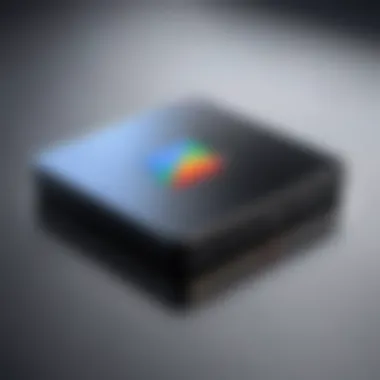In-Depth Look at Google Refurbished Devices


Intro
In the fast-paced world of technology, new devices flood the market every day, each touting cutting-edge features and enhanced performance. Amidst this frenzy, Google refurbished devices arise as a compelling alternative, offering a combination of quality, affordability, and sustainability. But what does purchasing a refurbished device really entail? Why might a seasoned IT professional or an avid tech enthusiast consider these devices over brand new ones?
This article aims to dissect the nuances surrounding Google refurbished products, helping readers grasp their key characteristics, understand the various aspects that come into play when purchasing, and recognize the implications of choosing refurbished technology in both personal and professional settings. Our exploration will not only shine a light on the pros and cons inherent in refurbished offerings but will also touch upon market trends and environmental considerations that add layers to this decision-making process.
Prelude to Refurbished Devices
In today's fast-paced technological landscape, the notion of refurbished devices has gained considerable traction. The appeal lies not just in the potential savings but also in the peace of mind that comes with understanding what one is purchasing. With Google stepping into this arena, there's an array of choices that offer both performance and reliability. A well-rounded grasp of refurbished products is essential for savvy consumers, especially those in the IT sector where making informed decisions can significantly affect budgets and operational efficiency.
Defining Refurbished Products
At the heart of the refurbished device market is a clear definition. Refurbished products are pre-owned devices that have been returned to the manufacturer or a third-party vendor, restored to a working condition, and then resold. This restoration process may involve repairs, replacing defective parts, or even giving the devices a new software update. It's essential to distinguish refurbished products from used ones—while the latter may have a history of wear and tear, refurbished items typically undergo rigorous testing to ensure functionality.
Some key aspects that define refurbished devices include:
- Quality Control: Before being resold, refurbished products undergo inspections to validate their performance and cosmetic condition. This means any major flaws are addressed prior to reaching the consumer.
- Warranty Coverage: Many refurbished products come with a limited warranty, offering a level of protection that one might not find when buying used items independently.
- Price Point: Typically, refurbished devices are offered at a significantly reduced price compared to new models, making them attractive for budget-conscious buyers.
The Role of Google in the Refurbished Market
Google's stake in the refurbished market marks a significant shift in how we perceive tech devices. As a frontrunner in innovation, their entry into selling refurbished products isn't merely about profit; it's about sustainability and providing consumers with viable options.
For Google, offering refurbished models means:
- Implementation of Sustainability: By participating in the refurbished market, Google demonstrates its commitment to reducing electronic waste. Refurbishing devices helps keep products in use longer and minimizes their impact on the environment.
- Boosting Accessibility: Quality technology should not be limited to those who can afford new devices. Refurbished options lower the entry barrier, allowing more people to engage with Google’s top-notch hardware, such as Chromebooks and Pixel devices. This brings a broader audience into the Google ecosystem.
- Trust through Transparency: Google's well-known brand comes with an expectation of quality. By offering certified refurbished products, they leverage their reputation to assure consumers of consistent quality and performance. This initiative also demystifies the refurbished process, fostering a climate of trust.
In summary, understanding refurbished devices—especially in the context of a major player like Google—highlights both the practical and ethical considerations that inform consumer choices today.
Benefits of Choosing Google Refurbished
When talking about buying technology, many individuals often run straight for the shiny new devices. However, the market for refurbished gadgets, particularly those from Google, has been gaining traction. This section explores the key benefits of choosing Google refurbished products, illustrating why they shouldn’t be dismissed outright by savvy consumers. Emphasizing aspects like cost efficiency, quality assurance standards, and sustainability, it becomes clear that these devices can be a smart choice for both everyday users and IT professionals alike.
Cost Efficiency Compared to New Devices
One of the most compelling reasons to consider a Google refurbished device is, quite frankly, the cost. Refurbished products can be significantly cheaper than their brand-new counterparts, sometimes saving the buyer upwards of 30% or more. Take, for instance, a Google Pixel smartphone; a new device might set someone back a thousand bucks, but a refurbished one could easily run only around seven hundred.
This cost-effectiveness extends beyond just the device itself. For companies looking to equip employees with technology, opting for refurbished models can result in substantial savings. These savings can then be redirected towards other aspects of the business that might need financial attention. Moreover, the overall ownership costs may also be lower, as certified refurbishments often come with warranties that provide reassurance against potential defects.
Quality Assurance Standards
It’s a common misconception that refurbished devices mean lower quality or reliability. Not so with Google. Their refurbished offerings generally go through rigorous quality assurance processes, ensuring that every product meets specific performance guidelines. The refurbishing process can include everything from cosmetic repairs to function checks, meaning that buyers often receive products that perform nearly as good as new.
Many refurbished devices undergo a multi-point inspection to ensure that they meet quality standards. That could mean battery life checks, software updates, and physical assessments to ensure the product looks good as new. Google often stands behind these products with limited warranties, providing an additional layer of confidence.
A refurbished Google device often provides the reliability you're looking for, minus the price tag that usually comes with new technology.
Environmental Impact and Sustainability
The environmental footprint of consumer electronics is substantial. By choosing refurbished devices, consumers contribute to a more sustainable approach to technology consumption. Refurbishing gadgets reduces e-waste and extends the lifecycle of these products, which is a win-win in terms of environmental conservation.


With resources being finite, buying refurbished also cuts down on the resources needed to produce new devices. For IT professionals who may be mindful of not just budget but also impact, this can align perfectly with company values centered on sustainability practices—an increasingly strong consideration in today’s market. This conscious choice reflects positively, showing concern for both the environment and corporate responsibility.
Key Considerations When Purchasing Refurbished
When it comes to purchasing a refurbished device, particularly from a well-known brand like Google, there are several key considerations to keep in mind. These factors not only influence the overall user experience but also ensure that you are making a sound investment. Knowing what to look for can be the difference between a device that meets your expectations and one that leaves you feeling disappointed. Incorporating considerations such as warranty, seller credibility, and product specifications can significantly enhance the buying process and outcomes.
Understanding Warranty and Return Policies
One of the first aspects to explore is the warranty and return policies associated with refurbished devices. Many buyers underestimate the importance of this element. A solid warranty gives you peace of mind, ensuring that if the device malfunctions within a certain period, you have recourse. Google’s refurbished devices often come with a limited warranty, which can span anywhere from 90 days to a full year — depending on the model and the seller.
Moreover, it's crucial to scrutinize the return policy. What happens if you receive a device that doesn’t function as expected? Is there a hassle-free return process in place? Knowing these details ahead of time can prevent significant headaches down the line. Ensuring you are covered for defects or faults that could arise allows you to make your purchase with confidence and assurance.
Evaluating Seller Credibility
Next up is evaluating seller credibility. The refurbished market has various players, and not all are equal in terms of quality and service. It’s vital to research the seller from whom you are considering buying. An ideal seller should have a robust reputation, possibly featured on platforms like reddit.com or facebook.com where customers share their candid experiences.
Pay attention to ratings and reviews. Third-party certifications can also help in gauging if the seller meets high standards. If you see negative reviews, especially consistent complaints about customer service or product quality, it might be best to look elsewhere. Trustworthy sellers often provide transparent information about their refurbishing processes, and they don’t shy away from addressing customer concerns directly. This level of accountability is a hallmark of a credible seller.
Inspection of Product Specifications
Finally, inspecting product specifications is where the rubber meets the road. You should never take a refurbished product at face value. By examining the details like battery life, storage capacity, and any included accessories, you can gain a full understanding of what you are investing in.
Asking questions about the specifications will not only help educate you on what to expect but also assist in making a more informed decision. If you are considering purchasing a Google Chromebook, for instance, you should verify that it has the necessary processing power for your needs. Not all devices will offer the same performance capabilities, and getting stuck with a model that doesn't meet your needs can be frustrating.
In essence, being diligent about specifications allows you to align the refurbished product with your personal or professional requirements, ensuring that you gain the most value from your purchase.
"Navigating the refurbished market can be tricky, but by focusing on warranty, seller credibility, and product specifications, you can enhance your overall experience."
By taking these key considerations into account, purchasing a refurbished device can indeed turn out to be a positive and fruitful experience, leading you to make an educated choice that aligns with both your budget and your needs.
Comparative Analysis: Refurbished vs. New
When it comes to choosing between a refurbished device and a brand-new model, understanding the differences can make a world of difference in the purchasing decision. This section will cover the aspects that are crucial for tech enthusiasts and IT professionals alike.
Performance Metrics
Performance is often a key concern when deciding whether to invest in a refurbished device or a new one. Generally, refurbished devices from reputable sellers undergo rigorous testing and certification processes. This ensures that they meet specific standards before being resold.
On the other hand, new devices typically boast the latest technology, featuring upgraded hardware and software capabilities. However, it's not uncommon for refurbished devices such as Google Pixel or Nest products to still perform remarkably well. The critical takeaway is that for many users, the performance gap might not be as significant as one may assume.
Some metrics to consider when measuring performance include:
- Speed: The responsiveness of the device during tasks.
- Battery Life: How long the device lasts under typical usage.
- Software Updates: The availability of updates for refurbished devices compared to new ones.
Longevity and Future-proofing
Another vital aspect is how long you can expect these devices to last and whether they will remain relevant for future technologies. New devices can often provide a sense of security regarding future-proofing because they incorporate the latest iterations of technology. Yet, refurbished devices, especially those still supported by Google, might also last several years, making them formidable contenders.
In terms of longevity, consider:


- Build Quality: Many refurbished products are still in excellent condition. However, it's essential to look for certifications that prove the device was well-maintained.
- Upgrade Potential: Some models allow for hardware upgrades, which can enhance their lifespan beyond what was originally intended.
- Support Services: New devices may come with longer support periods, but refurbished ones often come with adequate warranties that minimize risk.
Usage Scenarios: When to Choose Refurbished
Knowing when to opt for a refurbished product can save money without sacrificing quality. Scenarios include:
- Budget Constraints: If you're on a tight budget, refurbished devices can offer similar performance to new ones at a fraction of the cost.
- Casual Use: If your needs are limited to web browsing, streaming, or basic applications, a refurbished device may suffice and perform admirably.
- Testing Purposes: For developers and IT professionals who need devices for testing, going refurbished can save a few bucks while still providing adequate capabilities.
Popular Google Refurbished Models
In the world of tech, refurbished devices take center stage as savvy consumers seek out cost-effective options without sacrificing quality. Google’s revamped products have gained traction, catering to both budget-conscious individuals and eco-minded professionals. Understanding the popular Google refurbished models is crucial for anyone considering a purchase. This section highlights notable models like Chromebooks, Pixel devices, and Nest products, shedding light on their unique attributes and the value they bring to users.
Chromebooks: Accessible Computing
Chromebooks stand as a symbol of accessible computing. They offer lightweight, efficient performance suitable for everyday tasks such as browsing the web, managing emails, or working on documents. In the realm of refurbished options, these devices become even more appealing due to their affordability without compromising functionality.
One notable example is the Google Pixelbook Go. It combines sleek design with impressive battery life, allowing users to tackle their work on the go. Many find that a refurbished Pixelbook Go provides top-notch performance at a fraction of the cost of newer models. Moreover, Google ensures that each refurbished Chromebook undergoes stringent evaluation, ensuring they meet high performance benchmarks, making them reliable additions to any tech arsenal.
Key benefits include:
- Low Cost: Especially attractive for students or professionals aiming to minimize expenses.
- User-Friendly: Chrome OS allows even the least tech-savvy individuals to navigate with ease.
- Versatility: These devices cater to multiple usage scenarios, from casual browsing to serious productivity.
Pixel Devices: Compact Intelligence
When it comes to compact intelligence, few brands compete with Google’s Pixel devices. Known for their superior camera capabilities and integrated Google Assistant features, refurbished Pixel smartphones are a great option for those wanting cutting-edge technology at an accessible price.
For instance, a refurbished Google Pixel 5 offers a fantastic user experience. Its sleek design and strong performance have made it a favorite among tech enthusiasts. Additionally, buyers can enjoy the perks of software updates directly from Google, ensuring the device remains relevant longer than some competitors.
Some appealing features of refurbished Pixel devices include:
- High-Quality Cameras: Perfect for photography amateurs and enthusiasts alike.
- Regular Updates: Enhances device longevity and security.
- Sustainability: Buying refurbished contributes to reducing e-waste, making it a conscious choice for eco-aware consumers.
Nest Products: Smart Home Integration
In the realm of home automation, Google Nest products shine bright. These devices simplify daily routines with intelligent integration across various home applications. Refurbished Nest products can provide exceptional value as they usually come at lower prices while retaining the premium functionalities.
Consider the Nest Learning Thermostat. Even a refurbished unit can become a central part of your home. It learns your temperature preferences and adjusts accordingly, resulting in energy savings and enhanced comfort. Coupled with smart home systems, these devices can create a seamless living experience.
Why invest in refurbished Nest products?
- Cost Savings: High functionality can come at a lower price.
- Energy Efficiency: Incorporating smart technology can lead to substantial savings on energy bills.
- User-Friendly Setup: Many users find installation straightforward, making home automation accessible to everyone.
"Purchasing refurbished products from Google provides an opportunity for great technology at reduced costs while supporting sustainability."
In summary, Google’s range of refurbished models—from Chromebooks to Pixel devices and Nest products—highlights the brand's commitment to accessibility, quality assurance, and sustainability. As more consumers embrace this trend, understanding these popular devices becomes essential for making informed purchasing decisions.
Challenges in the Refurbished Market
The refurbished market offers a unique intersection of value and risk for consumers, particularly when it comes to technology. Understanding the challenges present in this space is essential for making informed purchases, especially for tech enthusiasts and IT professionals. While many individuals gravitate towards the lower price points and environmental benefits associated with refurbished items, they also navigate a landscape marked by potential pitfalls. The primary issues at play include variable quality and intense market competition. By exploring these factors, we open a dialogue about trust, sustainability, and economic reality in the refurbished sector.


Possible Quality Variability
With refurbished devices, not all are created equal. It’s like a box of chocolates—you never know what you’re gonna get. Some products may work as if they were fresh out of the box, while others might come with a range of hidden issues. Quality variability stems from various places: the initial condition of the device before refurbishment, the skill of the technician performing the refurbishing process, and the standards upheld by the seller. A company that claims to refurbish devices could still leave room for significant defects, raising doubts about reliability.
When considering a refurbished product, purchasers must dig deeper. This might mean looking up online reviews, consulting forums, and checking seller ratings on platforms like Reddit, where past buyers often share valuable insights. This legwork can help consumers distinguish between sellers who prioritize quality versus those who simply capitalize on the refurbished trend. Moreover, understanding the protocols employed during the refurbishment process can also give insight into what to expect regarding product performance and lifespan.
Market Saturation and Competitiveness
Another challenge worth scrutinizing is the saturation of the refurbished market. The rise of smartphones, laptops, and other tech gadgets has resulted in an influx of refurbished options flooding online and physical marketplaces. While variety is the spice of life, too many choices can muddle the purchasing process. Competing sellers often engage in aggressive pricing wars, which, while beneficial for consumers seeking the best deal, can make it tough to ascertain genuine quality. When prices are volatile, it can feel like a race to the bottom.
Consequently, deal-seekers may find themselves drawn to lower-priced options without sufficient consideration for seller reputation and product condition, making the situation more convoluted. Therefore, consumers are advised to look beyond just price reduction and to factor in aspects like warranty policies and product history to ensure they are making wise choices.
"In a crowded market, clarity becomes as valuable as the product itself."
The interplay of quality and competition paints a complex picture for consumers interested in refurbished devices. While the potential for great savings exists, it’s crucial to navigate this space thoughtfully, ensuring that a more affordable price doesn’t come with significant trade-offs in quality and reliability.
Consumer Sentiment Toward Refurbished Devices
In today's technology-driven world, consumer attitudes toward refurbished devices play a significant role in shaping the market. With innovations rolling out at a breakneck pace and products quickly becoming obsolete, refurbished devices offer a sustainable and economical alternative to new purchases. Understanding consumer sentiment on these products is vital since it not only influences buying behavior but also affects overall market trends.
Perceptions of Value and Trust
When it comes to refurbished devices, value perception is a double-edged sword. On one hand, consumers often see them as a cost-effective option for procuring quality technology. After all, who wouldn't want to snag a high-performance Chromebook or Pixel at a fraction of the original price? However, beyond the price tag lies an undercurrent of skepticism. Many potential buyers grapple with questions: "Is this device truly reliable?" and "Have there been any hidden defects?"
Trust is a crucial factor in this equation. The reputation of the refurbisher significantly impacts consumer confidence. For example, if a customer knows that Google stands behind its refurbished products, they're likely to be more at ease making a purchase. Moreover, buyer reviews on platforms like Reddit often help in navigating this tricky landscape. Positive feedback can transform wary consumers into informed buyers, while negative experiences can dampen enthusiasm.
"Many consumers equate purchasing refurbished devices to gambling. Trust must be earned to mitigate their fears."
Impact of Marketing Strategies
The marketing strategies employed by companies selling refurbished devices heavily shape consumer sentiment. Over the years, companies have recognized the need to reshape perceptions surrounding refurbished gadgets. Instead of focusing solely on the discounted price, they have started emphasizing quality and sustainability. Campaigns that highlight rigorous testing, quality assurance, and even warranty options help establish a narrative that refurbishing is as good as buying new.
Social media channels and influencers also play a pivotal role here. A tech reviewer showcasing the functionality of a refurbished Pixel can make all the difference. Their demonstration not only dispels myths but can trigger a wave of consumer interest. Platforms like Facebook and Reddit have seen conversations shift, as more users join forums dedicated to sharing their positive experiences with refurbished devices.
Closure and Future Outlook
As we wrap up our comprehensive look at Google refurbished devices, it’s crucial to recognize the significance of this topic. The refurbished market is not merely a subset of consumer goods; it's a specialized arena that reflects broader trends in sustainability, technology innovation, and economic shifts. By examining the landscape today, we not only understand what options are available right now, but we also glimpse what the future may hold.
The Evolving Nature of Refurbished Products
Refurbished products have seen a dynamic evolution over the past few years. Originally viewed with skepticism, these devices are increasingly accepted as credible alternatives to new ones. Companies like Google are spearheading this shift by implementing rigorous quality assurance standards and offering generous warranties. This evolving nature isn't just about the devices themselves; it's also about changing perceptions. Consumers are becoming savvier, realizing that they can acquire high-quality technology without the hefty price tags.
The enhancements in technology also dictate this evolution. As devices become more durable and easier to refurbish, the pool of available products expands. Take smartphones, for example: models that in the past might have been considered outdated are now refashioned with new parts, granting them a second life and enhancing their functionality. Furthermore, the newer generation of tech enthusiasts is more open to purchasing refurbished devices, often valuing the cost savings and potential eco-benefits over the allure of the latest model.
Implications for IT Professionals
For IT professionals, the implications of choosing refurbished devices are profound and far-reaching. First, consider the financial aspects. Organizations can save a lion’s share by opting for refurbished over new devices, allowing for reinvestment in other critical areas like staff training or infrastructure improvements. Additionally, understanding the specifications and the refurbishment process behind a device can empower IT professionals to make informed decisions that align with their organizational goals.
From a technical standpoint, these professionals need to continually assess performance metrics, system compatibility, and future-proofing strategies. It's essential to keep a finger on the pulse of the latest technology trends, as a refurbished device might require updates or ecosystem compatibility checks that a new device would typically handle out of the box. This brings about a greater responsibility to maintain a stable working environment while possibly deploying older technology.
In summary, navigating the refurbished market presents both challenges and opportunities for IT professionals. Diligently addressing quality, warranty protocols, and understanding each device's potential can lead to improved operational efficiencies, reduced costs, and even contribute to sustainability goals within organizations. As the landscape of refurbished devices continues to shift, remaining adaptable and informed will be essential for leveraging these products effectively in the tech space.
"The savvy consumer knows that purchasing refurbished isn’t merely about saving a buck; it’s a strategic decision with long-term gains."
Thus, as we look to the future, the importance of educated choices in the refurbished realm cannot be understated. From consumer habits to corporate strategies, the impact of how we approach refurbished technology will undoubtedly shape the way we interact with our devices for years to come.



